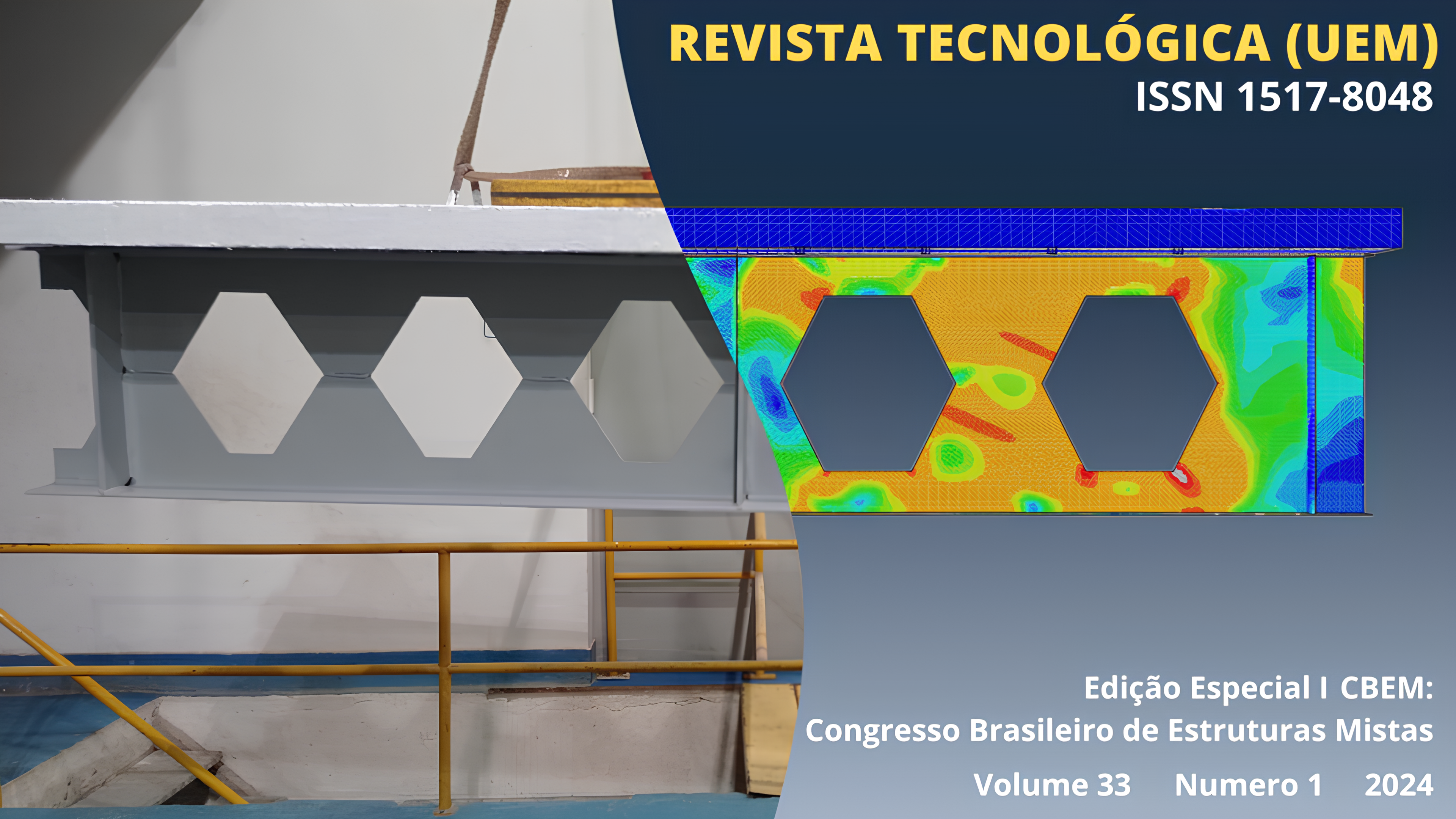EVALUATION OF THE PROPERTIES OF FOAMED CELLULAR CONCRETE PRODUCED WITH PARCIAL REPLACEMENT OF CEMENT BY RICE HUSK ASH
Abstract
Portland cement is, by mass, the most consumed manufactured product on the planet and its industry is responsible for approximately 7% of the world's anthropogenic CO2 emissions. The manufacture of cement's main component, clinker, requires a great deal of energy consumption and fuel burning, which generates high pollutant emissions. The use of supplementary cementitious materials (SCM) as a partial substitute for cement is an effective alternative for reducing cement consumption. Residual ash from agricultural activities is a good alternative for SCMs, including rice husk ash (RHA). This research therefore studied the effects of introducing RHA on the properties of foam cellular concrete. Three concrete dosages were used: REF, RHA-10 and RHA-20, with 0%, 10% and 20% cement replacement by RHA, respectively, by mass. The mechanical performance after 7 days of curing indicates that concrete with RHA can be used for non-structural purposes, while the performance after 21 days indicates that the RHA-10 mix is suitable for use as lightweight structural concrete. The addition of ash reduced the concrete's water absorption rate.
Downloads
References
ASSOCIAÇÃO BRASILEIRA DE NORMAS TÉCNICAS. NBR 9778: Argamassa e concreto endurecidos: Determinação da absorção de água por imersão - Índice de vazios e massa específica. Rio de Janeiro, 2005.
ASSOCIAÇÃO BRASILEIRA DE NORMAS TÉCNICAS. NBR 12655: Concreto de cimento Portland – Preparo, controle, recebimento e aceitação – Procedimento. Rio de Janeiro, 2022.
ASSOCIAÇÃO BRASILEIRA DE NORMAS TÉCNICAS. NBR 17054: Agregados – Determinação da composição granulométrica – Método de ensaio. Rio de Janeiro, 2022.
BERENGUER, R. A.; CAPRARO, A. P. B.; MEDEIROS, M. H. F.; CARNEIRO, A. M. P. Sugar cane bagasse ash as a partial substitute of Portland cement: Effect on mechanical properties and emission of carbon dioxide. Journal of Environmental Chemical Engineering, v. 8, n.2, 2020.
DE MAGALHÃES, L. F. et al. Iron Ore Tailing as Addition to Partial Replacement of Portland Cement. Materials Science Forum, v. 930, p. 125-130, 2018.
DE SOUZA MORAIS, I. et al. Sericitic Phyllite as Addition in Portland Cement. Materials Science Forum, v. 930, p. 131–136, 2018.
DUARTE, M. S. et al. Influence of mechanical treatment and magnetic separation on the performance of iron ore tailings as supplementary cementitious material. Journal of Building Engineering, v. 59, 2022.
FERNANDES, I. J.; CALHEIRO, D.; KIELING, A. G.; MORAES, C. A. M.; ROCHA, T. L. A.; BREHM, F. A.; MODOLO, R. C. E. Characterization of rice husk ash produced using different biomass combustion techniques for energy. Fuel, v. 165, p. 351-359, 2016.
GOMES, C. L. Avaliação mecânica e de durabilidade de concretos fabricados com resíduos de construção e demolição e cinza de casca de arroz. 2019. 65 p.Dissertação (Mestrado em Engenharia Civil), Programa de Pós-Graduação em Engenharia Civil, Centro Federal de Educação Tecnológica de Minas Gerais.
IPCC. Synthesis report of the IPCC sixth assessment report. [s.l: s.n.]. Disponível em:https://www.ipcc.ch/report/ar6/syr/downloads/report/IPCC_AR6_SYR_LongerReport.pdf
KIM, J. et al. Utilization of Different Forms of Demolished Clay Brick and Granite Wastes for Better Performance in Cement Composites. Buildings, v. 13, n. 1, p. 165, 2023.
LI, J et al. Mechanical Properties and Microstructure Analysis of Cement Mortar Mixed with Iron Ore Tailings. Buildings, v. 13, n. 1, p. 149, 2023.
MARTINS, M. L. F. et al. Magnesium industry waste and red mud to eco-friendly ternary binder: Producing more sustainable cementitious materials. Construction and Building Materials, v. 310, 2021.
MAYCÁ, J.; CREMONINI, R. A.; RECENA, F. A. Contribuição ao estudo da argila expandida nacional como alternativa de agregado graúdo para concretos leves estruturais (CLE). 2008. Monografia de especialização. Universidade Federal do Rio Grande do Sul, UFRGS.
MATOS NETO, J. A. et al. Sterile Clay Pozzolans from Phosphate Mining. Materials Research, v. 18, p. 230–234, 2015.
MELO, Guilherme Fabio de. Concreto celular polimérico: Influência da adição de resíduo poliéster insaturado termofixo. 2009. Tese de Doutorado, Programa de Pós-Graduação em Ciência e Engenharia de Materiais. Universidade Federal do Rio Grande do Norte. Natal-RN.
MOUMIN, G. et al. CO2 emission reduction in the cement industry by using a solar calciner. Renewable Energy, v. 145, p. 1578–1596, 2020.
PIRES, M. et al. Phosphate rock waste in the production of cement tile. Results in Engineering, v. 16, 2022.
ROSSIGNOLO, J. A. Concreto leve estrutural: produção, propriedades, microestrutura e aplicações. São Paulo: Pini. 2009.
SCRIVENER, K. L.; JOHN, V. M.; GARTNER, E. M. Eco-efficient cements: Potential economically viable solutions for a low-CO2 cement-based materials industry. Cement and Concrete Research, v. 114, p. 2–26, 2018.
SNIC. Sindicato Nacional de Cimento Portland. Relatório Anual, 2019.
SNIC. Sindicato Nacional de Cimento Portland. Relatório Anual, 2021.
UN-DESA. World Urbanization Prospects: The 2018 Revision (ST/ESA/SER.A/420) Demographic Research. New York: [s.n.].
URATANI, J. M.; GRIFFITHS, S. A forward looking perspective on the cement and concrete industry: Implications of growth and development in the Global South. Energy Research and Social Science, v. 97, 2023.
USGS. Mineral Commodity Summaries 2023. St. Louis: [s.n.]. Disponível em:
Os autores podem manter os direitos autorais pelo seu trabalho, mas repassam direitos de primeira publicação à revista. A revista poderá usar o trabalho para fins não-comerciais, incluindo direito de enviar o trabalho em bases de dados de Acesso Livre.










